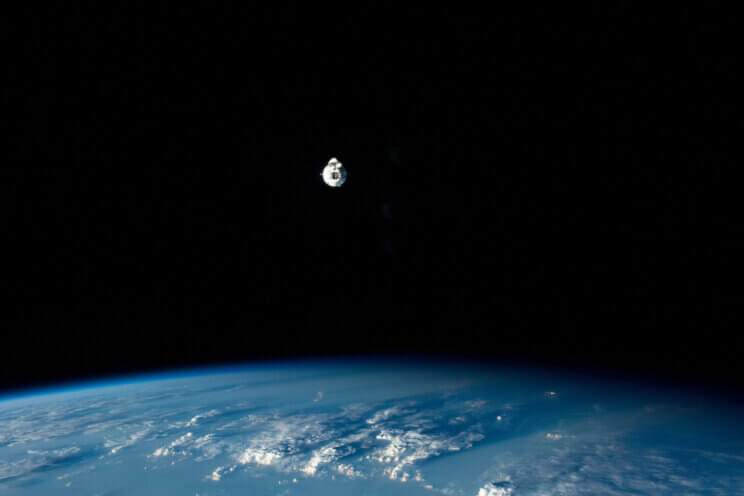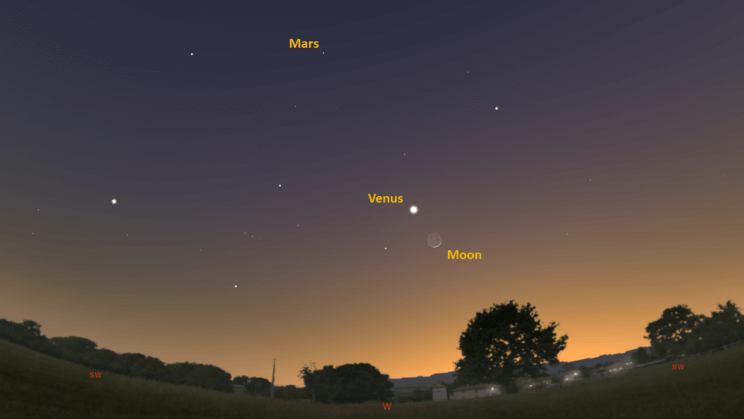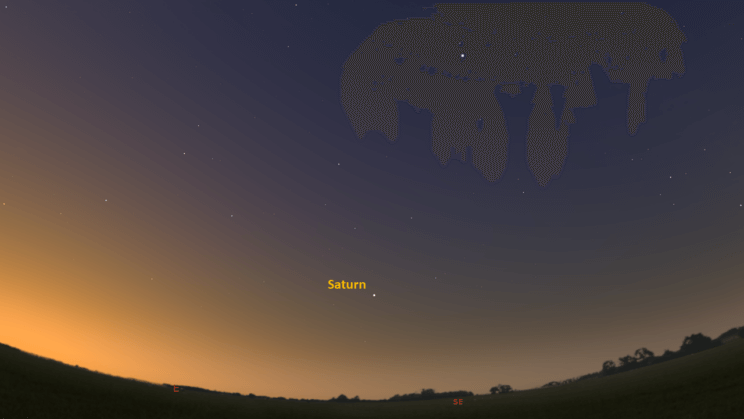This is the Saint Louis Science Center’s NIGHT SKY UPDATE for the week of Friday, April 21, 2023.
Information updated weekly or as needed.
Times given as local St. Louis time which is Central Daylight Time (CDT). For definitions of terminology used in the night sky update, click the highlighted text. If relying on times posted in Universal Time (UT), St. louis is -5 hours when CDT.
Public Telescope Viewings
As part of the Saint Louis Science Center’s First Fridays, weather permitting, the St. Louis Astronomical Society and the Science Center will set up a number of telescopes outdoors and be on-hand to answer your questions. Telescope viewing begins once it is dark. Regardless of the weather on May 5, join us indoors in our planetarium theater for “The Sky Tonight”. Showtime is at 7 p.m.
Observing Highlight of the Week

Satellites are interesting targets to track down on any clear night. Even in urban areas with light pollution, there are numerous satellites to look for. Sitting outside long enough you will quickly see numerous satellites as they pass overhead.
To start spotting satellites, you need a few things. Most important is a resource that lists pass times for your viewing area. Additionally, binoculars will help spot fainter satellites that may be difficult to see in light polluted skies. Lastly, a chair that reclines will help you take in more of the sky in a single view.
The resource I use when spotting satellites is the website Heavens-Above.com. Both their app and webpage contain loads of information, but I prefer their app. Unfortunately, the last I saw, it was only available for Android users. Apple users should investigate an app called Satellite Tracker. I have never used it, but it is connected to their popular Star Walk software. When using these resources, you will need to set your viewing location.
The Heavens-Above app will give you several options, one of which is a list of nightly events. Using this you click on an event you want to see, which opens a star map showing the path of the object. If you happen to see a satellite randomly, the app also has live star chart option that will show the path of any satellite currently passing overhead. When using this app, you will want to set a magnitude limit for what it will display. Magnitude settings go as low as magnitude 10 which requires a telescope to see, but for urban viewers magnitude 3.5 is a good place to begin.
Satellites become visible temporarily as they reflect sunlight. The easiest satellites to start with are the International Space Station and the Chinese space station called Tiangong. Being the largest satellites currently orbiting Earth, they can become brighter than any other satellite. Currently, ISS is exhibiting early morning passes while Tiangong is shifting into early evening passes.
Some satellites will appear to brighten and fade as they orbit Earth. These are often spent rocket stages that are tumbling as they orbit Earth.
For those with telescopes, an interesting project to undertake is trying to spot geosynchronous satellites. These are typically weather satellites that orbit in a way that they always see the same area of Earth. This occurs because their orbital speed matches the rotation rate of Earth allowing them to hover over the same spot. Sky and Telescope wrote a great article describing how to spot geosynchronous satellites. You can find that here.
Satellites make for a good addition to a night of observing. On any clear night, there are hundreds of satellites to spot. For those planning to go out and look for meteors this week, satellites will help occupy your time as you wait for those quick views of meteors.
The Sun and Moon

The Moon as seen from the International Space Station, on July 31, 2011.
Credit: NASA
Sunrise is at 6:16 a.m. on Friday, April 21 and sunset is at 7:43 p.m. providing us with about 13.5 hours of daylight. Even after sunset, light from the Sun will dimly illuminate our sky for roughly 1 hour and 40 minutes. This period is called twilight, which ends around 9:20 p.m. this week. For those with a sundial, local noon occurs around 12:59 p.m. this week.
| Day | Sunrise | Sunset | ||||||||||
|---|---|---|---|---|---|---|---|---|---|---|---|---|
| 21-Apr | 6:16 a.m. | 7:43 p.m. | ||||||||||
| 22-Apr | 6:15 a.m. | 7:44 p.m. | ||||||||||
| 23-Apr | 6:14 a.m. | 7:45 p.m. | ||||||||||
| 24-Apr | 6:12 a.m. | 7:46 p.m. | ||||||||||
| 25-Apr | 6:11 a.m. | 7:47 p.m. | ||||||||||
| 26-Apr | 6:10 a.m. | 7:48 p.m. | ||||||||||
| 27-Apr | 6:09 a.m. | 7:49 p.m. | ||||||||||
| 28-Apr | 6:07 a.m. | 7:50 p.m. | ||||||||||
| 29-Apr | 6:06 a.m. | 7:51 p.m. |
Moon
Moonrise for Friday, April 21 is at 7:03 a.m. and moonset occurs at 9:45 p.m. Friday, April 21, the Moon will exhibit a waxing crescent phase with 4% of the lunar disk illuminated. First quarter moon occurs on April 27, 2023, at 4:20 p.m.
International Space Station (ISS) Observing

There are several visible passes of ISS from St. Louis for the week of April 21. They occur during morning hours. These passes for this week are listed below. Use the table below for information about these passes.
Catch ISS from St. Louis starting Friday, April 21
| Date | Starts | Max. altitude | Ends | |||||||
|---|---|---|---|---|---|---|---|---|---|---|
| Time | Alt. | Az. | Time | Alt. | Az. | Time | Alt. | Az. | ||
| 24 Apr | -3.7 | 5:17:10 | 17 | WSW | 5:19:36 | 69 | NW | 5:22:58 | 10 | NE |
| 25 Apr | -3.6 | 4:30:35 | 55 | S | 4:31:02 | 64 | SE | 4:34:23 | 10 | ENE |
Magnitude (Mag): The Measure of brightness for a celestial object. The lower the value is, the brighter the object will be.
Altitude (Alt): The angle of a celestial object measured upwards from the observer’s horizon.
Azimuth (Az): The direction of a celestial object, measured clockwise from an observer’s location with north being 0°, east being 90°, south being 180° and west being 270°.
For information about ISS flyovers and other visible satellites, visit www.heavens-above.com
Detailed information regarding all unmanned exploration of our universe, missions past, present, and planned, can be found at Jet Propulsion Laboratories:
The Visible Planets

Looking west at 8:10 p.m. on April 22, 2023. Credit: Stellarium, EG

Looking Southeast at 5:45 a.m. on April 23, 2023. Credit: Stellarium, EG
This week, three naked eye planets will be visible. Venus and Mars are found in the west after sunset. Saturn is now visible in the southeast about 30 minutes before sunrise.
Venus
Venus is now well into its current evening apparition. Venus will be a bright target in the west after sunset until August 2023 when it approaches inferior conjunction. This week, look for Venus in the west about 20 minutes after sunset. Venus sets at 11:10 p.m.
Mars
Mars now rises before sunset, becoming visible once it is dark. Look for it high in the west about 30 minutes after sunset. Mars sets by 1:28 a.m.
Saturn
Saturn is slowly climbing out of the Sun’s glare about 30 minutes before sunrise. For many of us, Saturn may still be too low to spot due obstruction along the horizon. 30 minutes before sunrise, Saturn will appear roughly 10° above the southeastern horizon.
James S. McDonnell Planetarium
Night Sky Update: April 21 – 29, 2023






